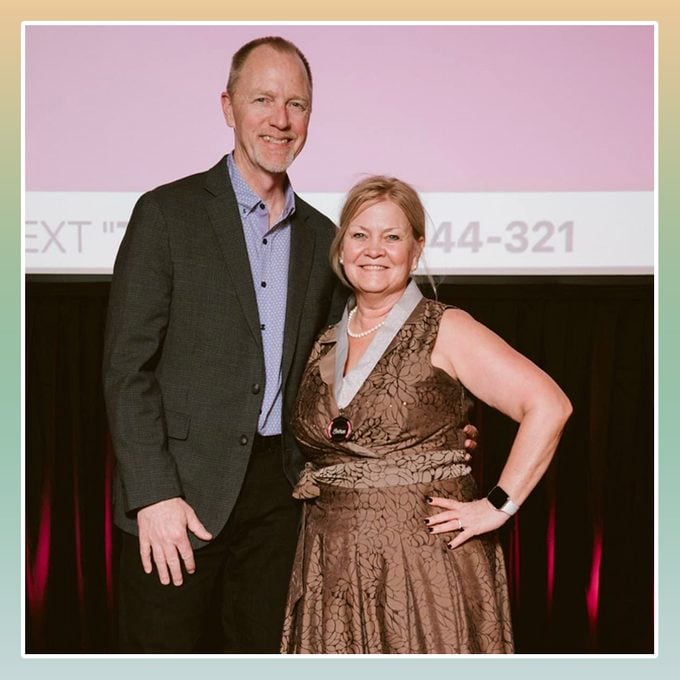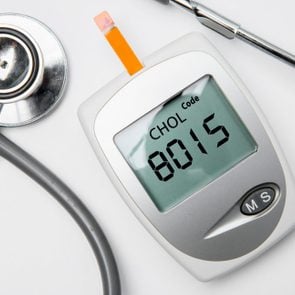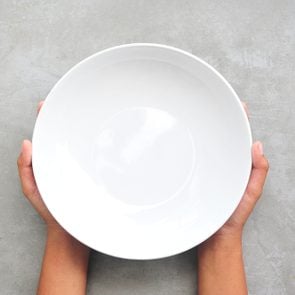My Breast Lump Wasn’t Cancer—It Was a Sign of High Cholesterol
Updated: Sep. 07, 2021
After discovering breast lumps, Kris Olsen thought she was in for a cancer diagnosis. Instead, her doctor diagnosed her with lipomas, fatty deposits under the skin that can be a sign of high cholesterol.

There’s a reason doctors take high cholesterol so seriously. Hypercholesterolemia, the official name for high cholesterol, is defined as having a total blood cholesterol of 240 mg/dl or higher. Borderline high cholesterol (levels between 200 mg/dl and 239 mg/dl) is also concerning, and affects nearly 40 percent of American adults. High cholesterol increases your risk for heart disease and stroke, but usually has no symptoms, making it a silent killer. There are a few conditions associated with high cholesterol, however, including lipomas, fatty tissue deposits under the skin. Here, Kris Olsen, 57, owner of Finish Line Engraving in Columbus, Ohio, shares her experience dealing with high cholesterol after learning lumps in her breast were really lipomas.
I discovered lumps in my breast
Some people describe their health as a journey. I’d say mine is more like a roller coaster—plenty of ups and some downs, along with a couple of stomach-dropping turns.
It started about 15 years ago, when I lost my best friend, my dad, and my brother to cancer in the space of three years. I’d spent so much time being a caregiver to my loved ones that I’d put my own well-being on the back burner.
I knew I’d gained some weight and was probably depressed, but I was shocked when I went in for my regular checkup and discovered how bad the numbers on my blood work really were.
Not only was I obese, but my cholesterol, triglycerides, and blood pressure were high, putting me at risk for cardiovascular disease. I knew that obesity raised my cancer risk too. This thought was at the top of my mind when I mentioned to my doctor that I had also found some lumps in my breast and armpit.
Thankfully, it wasn’t breast cancer
Several mammograms later (as if one isn’t enough fun!), we determined the lumps were knots of fatty tissue called lipomas.
The great news: the cause wasn’t cancer. The not-so-great news: my body was storing excess fat. Lipomas, I later learned, are often correlated with very high cholesterol.
My doc gave me a choice. I could drastically change my lifestyle, or he would put me on prescription meds, and a lot of them. I chose the lifestyle changes option.
I changed my diet and took up running, eventually taking part in a 5K race. Even though I had to walk sometimes, I found running therapeutic and fell in love with the sport. It also helped me mentally. Running became my “me time,” and I often cried, meditated, and sang while I worked out.
Over time, I lost the extra weight, the fatty lumps, and four inches of chest and back fat. But even more important, my cholesterol and blood pressure fell to healthy levels.
For the next decade, I kept up my healthy lifestyle. I thought, possibly naively, that I’d figured this cholesterol thing out.
Then menopause hit like a freight train
In February 2019, at age 55, I had another shocking medical checkup. My cholesterol was 275 mg/dl, a number classified as “extremely high” and dangerous.
I was totally taken aback. I didn’t have any symptoms at all! I remember feeling so scared. My mother had a heart attack when I was 16, and I was terrified of following in her footsteps.
The number was so much higher than I thought it would be, and I felt ashamed I’d let myself get to this point. I was in a fog as I listened to my doctor tell me that I needed to get these numbers under control immediately.
High cholesterol is more common in post-menopausal women, but I knew that I couldn’t use hormones as an excuse. I admitted that over the past few years I’d really let my diet and exercise habits slip. After getting an injury during a race, I’d stopped running, and I’d been comforting myself with food.
Again I was faced with a choice between going on medication or overhauling my life. Again I chose to change my lifestyle.
Managing my high cholesterol with diet and exercise
My sports doctor reassured me that I could lower my cholesterol through diet and exercise, and he recommended that I switch to eating a Mediterranean diet full of whole grains, fresh fruits and vegetables, and lean protein.
I love to cook, so I saw this as a fun opportunity to try out new recipes.
Another important factor was staying hydrated—and with the right liquids. I hadn’t been drinking much water, so I ditched sodas and juice and started downing water throughout my day. I added slices of lemons, oranges, or cucumbers to make it more fun and the water taste better.
One thing that didn’t help me was vinegar. I read on the Internet that drinking apple cider vinegar daily can help lower cholesterol. I never got to find out if it really worked (researchers are still debating this) because I just couldn’t stand the taste!
The exercise piece was a bit trickier. I couldn’t run like I used to, so my husband surprised me with an indoor bike trainer, and I took up cycling. Eventually I was able to take up running again, and I’ve rekindled my love for it.
One year later
My checkup in February 2020 went much better. In one year, I’d been able to get my total cholesterol down to 197 mg/dl—that’s in the healthy range for my age. I was so proud of my hard work, and today I feel so much healthier and happier.
But while my story worked out well, not everyone’s does. Now I make it a point to tell everyone that high cholesterol usually does not have any symptoms so it’s super important to have blood work done on a regular basis.
We can’t control all the ups and downs on our health roller coasters, but cholesterol is one area where we really can have a big effect.
—As told to Charlotte Hilton Andersen




















